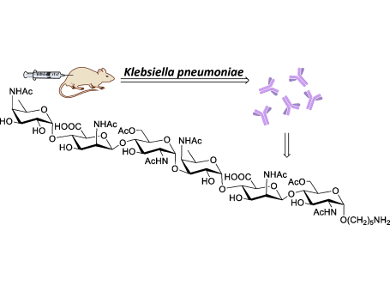Enterobacterial Common Antigen Relevant for Immunotherapy Chemically Synthesized
Immunotherapy using monoclonal antibodies is a promising treatment strategy, and it might now be within reach: American scientists have successfully prepared an oligosaccharide enterobacterial antigen for which a monoclonal antibody has been developed. The study is published in the journal Angewandte Chemie.
Monoclonal antibodies are indispensable as diagnostic tools in biomedical applications and are increasingly used in therapy. As Enterobacteriaceae, a large family of gram-negative pathogens with as prominent members as Escherichia coli, Salmonella, or Klebsiella, can develop resistance against multiple antibiotics and can thus cause severe infections with high mortality, the development of monoclonal antibodies for a new therapeutic approach is required. Geert-Jan Boons at the University of Georgia, USA, and his group, in collaboration with MedImmune, USA, chose the enterobacterial common antigen (ECA), an oligosaccharide, as a target antigen because it is expressed by all members of this bacterial family. The hope was that a monoclonal antibody recognizing ECA would recognize the pathogens in general and thus provide the basis for vaccines or immunotherapy. The authors explain: “Although ECA can be isolated from natural sources, chemical synthesis offers a much more attractive approach for obtaining such compounds. It allows the installation of reactive linkers for controlled conjugation of oligosaccarides to carrier proteins.”
First Chemical Synthesis of ECA-derived Oligosaccharides
However, before conjugation and evaluation of ECA, the Boons group, which dedicates its research to carbohydrate sciences, had to meet the extraordinary task of synthesizing the challenging molecule. It contains highly functionalized monosaccharides, the glycosidic linkages were difficult to install, and the central monosaccharide formed internal linkages rather than undergoing glycosidic linking. Finally, they succeeded with two hexasaccharides and two trisaccharides as synthetic variants of ECA. After conjugation to bovine serum albumin, which is a widely used carrier protein, natural antisera effectively bound to the variants and especially to the central trisaccharide unit, the synthesized epitope for which the monoclonal antibody was then successfully developed as well.
As multiresistant bacteria pose the threat of incurable infections, the development of monoclonal antibodies as a potential new therapeutic approach against pathogenic bacteria is highly significant. Boons and Wang and their colleagues have laid the basis by identifying and preparing the immunogenic target.
- Synthetic Enterobacterial Common Antigen (ECA) for the Development of a Universal Immunotherapy for Drug-Resistant Enterobacteriaceae,
Lin Liu, Jingying Zha, Antonio DiGiandomenico, Douglas McAllister, C. Kendall Stover, Qun Wang, Geert-Jan Boons,
Angew. Chem. Int. Ed. 2015.
DOI: 10.1002/anie.201505420




